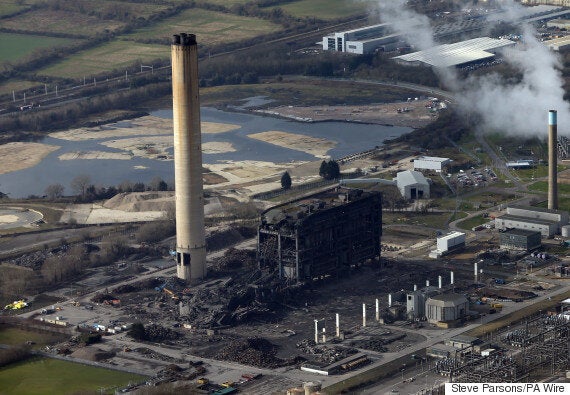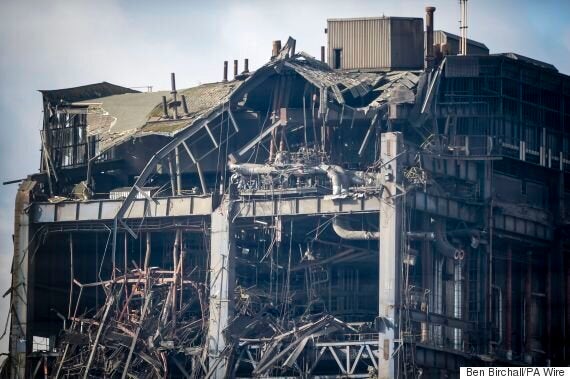It is "highly unlikely" that the three people missing after part of Didcot power station in south Oxfordshire collapsed are alive, rescuers have said.
A concrete and steel structure at the Didcot A site came down around 4pm on Tuesday while it was being prepared for demolition, killing one person and hospitalising a further five. A further 50 were treated for dust inhalation at the scene, where a "major incident" was declared.
Emergency crews with sniffer dogs worked into the night on Tuesday searching for the missing, and have since said the operation could take "several days".

Rescuers workers have said it is 'highly unlikely' that the three people missing after the Didcot power station collapse are alive
Oxfordshire Assistant Chief Fire Officer Simon Furlong said: "It is still a rescue operation at the moment.
"We have three dog teams on site working overnight, but we haven't picked up any clear signs of life.
"We are continuing to search and locate the missing persons and we are working hard with the other agencies."
Furlong said the operation was being hampered because of safety concerns: "This is a very difficult situation with a very unstable structure.
"The safety of emergency service personnel has to remain our priority, while recognising how hard this must be for families waiting for news of loved ones overnight. Our sympathies are with them, and the family of the person who died here yesterday."
A rescue expert from Cheshire with similar experience is due to the site on Wednesday, as police take control of the operation. A 100m cordon has been placed around the scene as the rescue operation continues.
Earlier Furlong had been quoted as saying: "We've had some signs (of life) from the search dogs, but this is a very difficult with the debris field.
"We've had no significant signs, but that doesn't mean to say there isn't saveable lives still within the building."
Oxfordshire deputy chief fire officer Nathan Travis said late Tuesday that specialist urban search and rescue teams, including sniffer dogs, are at the "challenging" site from as far away as the West Midlands.
He said: "The building is potentially 10 storeys high, half of that building has collapsed, so you have got a rubble pile which is approximately 20 to 30 feet deep at the moment.
"The search will be considerable due to the instability of the site, we expect the search to continue throughout the night and possibly into the coming days."
Asked what the chances were of finding the missing alive he replied: "At the moment I can't give you any details on that but it is a substantial collapse of a building."
A GMB union official told the Press Association: "We understand that workers were preparing two boilers for demolition in the coming weeks. This led to the collapse of a building."
Oxford University Hospitals NHS Foundation Trust said five casualties were taken to the John Radcliffe Hospital in Oxford.
A spokesman said: "Four of the men are in a stable and non-life threatening condition, while one man is in a serious but not life-threatening condition."
Residents in a mobile home park close to the site said they heard a rumble but no bang when the collapse happened.
Colin King, 44, who has lived near the power station for the past 18 years, said: "There was no bang, just a loud rumble. Normally we get given information on anything big they're doing. We usually hear small bangs but I knew something was out of the ordinary."

Workers were preparing two boilers for demolition in the coming weeks when the collapse occurred
He said the dust from the collapse was the same as when the towers were brought down last year.
David Cooke, whose company Thames Cryogenics has a building overlooking the power station, said: "Our building shook and as we looked out of the window, the end of the main turbine hall collapsed in a huge pile of dust.
"It totally obscured the towers and must have drifted across the roads and main rail line. What's left looks a tangled mess.
"The dust was hanging over the area for five to 10 minutes."
Didcot A opened in 1970 as a coal-fired power station and was later converted so it could also generate power from natural gas.
It ceased generation in March 2013 and hundreds gathered to watch when three of its enormous cooling towers were blown up in July 2014 after dominating the town's skyline for more than four decades.
According to the RWE npower website the total demolition of the site is expected to be complete by the end of this year.
The incident comes 16 months after a major fire struck a cooling tower at Didcot B in October 2014.
The blaze affected 50% of the station output - supplying a million homes.
